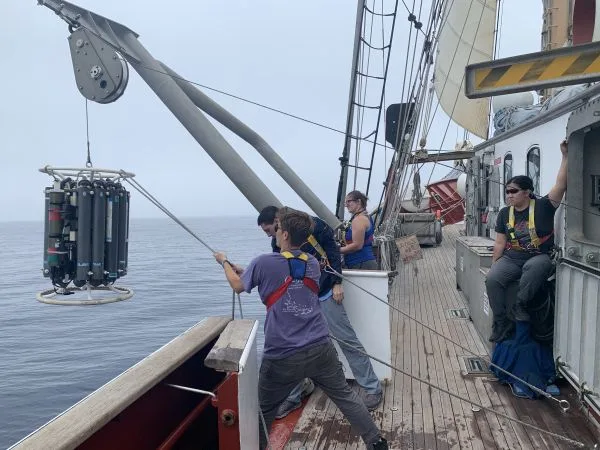News
First Morning Deployment

Ship’s Log
Position
33°50.4’N x 119°00.9’W
Heading
302°
Speed
7 kts
Sail Plan
Forestays’l, Main stays’l, mains’l
Weather
Cloudy
Wind
Light WxS force 1.
Description of location
We are by the Channel Islands.
This morning was our first official morning station. It started with Haylie going around collecting Secchi bets. There wasn’t much wind this morning so we were motor sailing under the forestays’l, main stays’l and main. Before we could stop for station we had to pull the stays’ls across so that they were set up for a starboard tack. Once we did that we motored around so we were hove to on a port tack, which means that our sails are trimmed super inefficiently and our rudder was hard over to the side the wind is coming from. This maneuver allows us to stop forward motion and just drift down wind. This is the perfect set up to put our hydro wire over the side.
Our everyday morning stations consist of three deployments and a surface station. Our first deployment was a secchi disk; this allows us to determine where the 1% light level will be on the water column. Secchi disks are super fun, we all place bets to see how deep the secchi disk will be before we lose sight of it, it’s price is right rules, closest bet wins but you can’t go over. Payton won with a bet of 22, the actual depth was 22.5. After we brought the secchi disk back onboard we deployed the hydrocast. As seen in the picture it is this large carousel consisting of 12 niskin bottles, which are used to collect water from different depths, the CTD, which collects Conductivity, Temperature, and Depth data, an AFM, automated firing mechanism which tells the bottles when to collect water, a Par (collects light levels), Chlorophyll a, and a dissolved oxygen meter.
We usually want to send the hydrocast down to 1000M but because we were in only 900M of water, we decided to only send it down to 800M. While the hydrocast was going down and then coming back up, we did a surface station using our flow through.
The flow through consists of 5 instruments that sea water is pumped into from a sea chest at the bottom of the hull and empty into the sinks in the wet lab. We were able to collect water samples from that system to look at the pH, extracted chl-a, and nutrients of the water at the top of the water column in the place where we were doing the hydrocast.
Once we got the hydrocast onboard, all of the bottles closed, YAY, we cleaned up and started to get the boat moving 2 kts for our neuston tow. It was the first neuston tow of the trip and we caught a pipe fish! Overall we had a great first morning station and the students learned a lot. We are all very excited to do more science as we head out to the gyre.
– Sophie “Supi” Vallas, 1st Assistant Scientist / B Watch
Happy Birthday Leah! I hope you had an amazing day, and I’m sending you a huge hug! Dean please send the link to the blog to Leah so she sees this!
Contact: Douglas Karlson, Director of Communications, 508-444-1918 | dkarlson@sea.edu